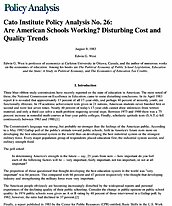Three blue-ribbon study commissions have recently reported on the state of education in American. The most noted of these, the National Commission on Excellence in Education, came to some disturbing conclusions. In its April 1983 report it is revealed that approximately 13 percent of all 17-year-olds, and perhaps 40 percent of minority youth, are functionally illiterate. In 19 academic achievement tests given in 21 nations, American students never finished first or second and were last seven times. Nearly 40 percent of today’s 17-year-olds cannot draw inferences from written material, and only a third can solve a math problem requiring several steps. Between 1975 and 1980 there was a 75 percent increase in remedial math courses at four-year public colleges. Finally, scholastic aptitude tests (S.A.T.s) fell continuously between 1963 and 1980.[1]
The Commission’s language was strong, but probably no stronger than the feelings of the American public. According to a May 1982 Gallup poll of the public’s attitude toward public schools, faith in America’s future rests more on developing the best educational system in the world than on developing the best industrial system or the strongest military force. Every major population group of respondents placed education first, the industrial system second, and military strength third.
The poll asked:

